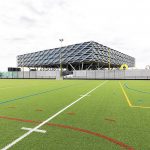By Thomas J. Ryan
Activewear brand Delta Apparel Inc. (NYSE:DLA) reported earnings declined in its fiscal fourth quarter due to costs associated with its manufacturing realignment and an extra week in the year-ago quarter. Results were also skewed by a tax loss in the latest period versus a tax gain in the year-ago period. Excluding those items, earnings were up slightly, including its Activewear segment, and margins also picked up.
Net earnings in the period ended October 1 slumped 45.6 percent to $2.3 million, or 29 cents a share. Costs associated with the manufacturing realignment reduced earnings by 11 cents per share in the latest period. The current quarter ran 13 weeks versus 14 weeks in the year-ago quarter, while the latest period reflected a tax expense versus a tax benefit a year ago. Excluding all extraneous factors, earnings would have increased to 55 cents a share from 53 cents a year ago. Revenues in the quarter were down 4.8 percent in the period to $114.4 million. Excluding the extra week, sales were up 2.5 percent.
Gross margins for the fourth quarter were 20.9 percent compared to 21.9 percent in the prior-year quarter. Excluding the impact of the manufacturing realignment, however, gross margins expanded in both the company’s Basics and Branded segments. A shift to a higher mix of basics sales resulted in the slight decline in margins overall for the quarter.
On a conference call with analysts, Robert W. Humphreys, chairman and CEO, noted that the company over the last two years has taken several steps to reduce its fixed cost structure, streamline business operations and lower production costs. “By focusing on key growth areas, we successfully navigated through a tough retail environment, and our fourth quarter highlights the momentum we have headed into fiscal year 2017,” Humphreys said.
He noted that the company achieved gross margin expansion throughout fiscal year 2016, and anticipates this trend to continue and strengthen in fiscal year 2017 as the benefits from the completed manufacturing realignment are realized. Humphreys added, “We continue to expand our output, which should allow for inventory levels that better support our growing catalog business this spring. We are also producing open-width fabrics, and are meeting our $2 million cost savings goals for this initiative.”
Activewear Sales Up
By segment, net sales in Basics eased 0.9 percent to $73.7 million versus the same period a year ago. Adjusting for the additional week of sales in the prior-year quarter, sales grew 6.7 percent, with sales increasing 5 percent in Activewear and 34 percent in Art Gun. Activewear benefited from nearly double-digit growth within fashion basics, as well as expanded private-label programs. Art Gun’s continued rapid growth was driven by its expanded customer base and new product lines with existing customers.
Net sales in the Branded segment declined 11.1 percent to $40.7 million. The decline was due primarily to a $5.3 million decrease at Junkfood, resulting from the impact of the additional week of sales in the prior year coupled with the soft retail environment.
After reducing the prior-year quarter for the additional sales week, Salt Life sales grew 20 percent over the prior-year quarter, attaining 27 percent growth for the full year. Strong demand for the Salt Life brand continued, with good sell-through of its spring line driving reorders and robust initial fall shipments. Sales on saltlife.com grew 66 percent in the quarter. A second Salt Life store will open in San Clemente, CA in early 2017 to build on the ongoing success of the brand’s store in Jacksonville, FL.
Soffe grew net sales in the fourth quarter and saw a gain of 8 percent when adjusting for the additional week in the prior year. The Soffe growth was driven by expansion in strategic sporting goods and e-retailer channels. Humphreys said Soffe’s growth was “fairly broad based.” One or two strategic sporting goods store partners are expanding the brand “in a major way,” Amazon is “growing rapidly,” and Soffe’s military business is “solid.” Soffe’s business-to-business e-commerce site, re-launched in May 2016, is driving additional business particularly with independent sporting goods accounts, with sales up 5 percent in the fourth quarter and up 16 percent during the second half of the fiscal year. Humphreys added, “I’d say still plenty of work to do to get the revenue and momentum back that we would like at Soffe, but it was nice to see some growth and feel good that we are in a position of improvement going into fiscal 2017.”
Delta Apparel also recently completed the acquisition of Coast Apparel, a beach-lifestyle brand based in Greenville, SC. Humphreys said the brand has high-growth potential similar to Salt Life and Art Gun. The brand is primarily sold direct-to-consumer through its e-commerce site and two South Carolina stores. “We are excited about Coast’s geographic versatility across regional markets, which we believe can be leveraged using the strength of Delta’s infrastructure and expertise,” said Humphreys. He added that Delta Apparel continues to evaluate other such acquisition opportunities. In May, the company amended its credit facility to lower its debt costs by 50 basis points to provide greater financial flexibility.
“Although we anticipate the retail environment will continue to be a challenge in fiscal 2017,” Humphreys said, “we can see that our strategic initiatives completed in the past year have created momentum that we expect to result in sales growth, expanded margins and higher profits in fiscal 2017 and beyond.”
Photo courtesy Soffe
















